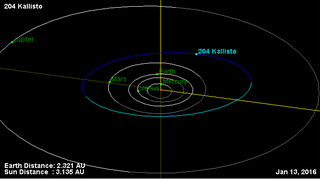
Dejanira is a main belt asteroid that was discovered by Alphonse Borrelly on 1 December 1875, and named after the warlike princess Deianira in Greek mythology. The Dejanira family of asteroids is named after it.

Menippe is a main belt asteroid. The object has a bright surface and rocky composition. It was discovered by C. H. F. Peters on June 18, 1878, in Clinton, New York, and named after Menippe, one of the daughters of Orion in Greek mythology.

Kallisto is a fairly typical, although sizeable Main belt asteroid. It is classified as an S-type asteroid. Like other asteroids of its type, it is light in colour. It was discovered by Johann Palisa on 8 October 1879, in Pola, and was named after the same nymph Callisto in Greek mythology as Jupiter's moon Callisto.

Martha is a large main belt asteroid. It is a dark, primitive carbonaceous C-type asteroid. This object was discovered by Johann Palisa on 13 October 1879, in Pola and was named after Martha, a woman in the New Testament.

Hedda is a sizeable Main belt asteroid. It is a C-type asteroid, meaning it is primitive in composition and dark in colour. This asteroid was discovered by Johann Palisa on October 17, 1879, in Pola and was named after Hedwig Winnecke, wife of astronomer Friedrich A. T. Winnecke.

Philosophia is a large main-belt asteroid that was discovered by the French astronomer Paul-Pierre Henry on August 12, 1882, in Paris and named after the topic of philosophy. Based upon photometric observations, it has a synodic rotation period of 52.98 ± 0.01 with a brightness variation of 0.15 ± 0.02 in magnitude.
Clementina is a large main belt asteroid that was discovered by French astronomer Henri Joseph Anastase Perrotin on 11 October 1885 in Nice, France. The origin of the name is not known.

Regina is a typical, although fairly large, Main belt asteroid. It was discovered by Auguste Charlois on 3 August 1889 in Nice, France. The asteroid is a suspected interloper in the Eucharis asteroid family.

Thora is a 17 km Main belt asteroid with a potentially long 274-hour rotation period. It was discovered by Johann Palisa on 6 October 1890 in Vienna.
Petrina is a minor planet orbiting the Sun.
Friederike is a minor planet orbiting in the asteroid belt. It is a member of the Hygiea family of asteroids.
Reginhild is a minor planet orbiting the Sun that was discovered by German astronomer Max Wolf on September 19, 1905. The name may have been inspired by the asteroid's provisional designation 1905 RD.
610 Valeska is a minor planet, specifically an asteroid, orbiting primarily in the asteroid belt. Discovered in 1906 by Max Wolf. The origin of the name is unknown, but it may be related to the provisional designation 1906 VK. In Slavic origin, it also means Glorious ruler. Photometric observations provide a rotation period of 4.9047±0.0002 h with a brightness variation of 0.17±0.03 in magnitude.
649 Josefa is a minor planet, specifically an asteroid, orbiting primarily in the asteroid belt. Photometric observations provide a rotation period of 10.481±0.001 h with a brightness variation of 0.33±0.04 in magnitude.
652 Jubilatrix is a minor planet, specifically an asteroid orbiting in the asteroid belt. It was discovered on 4 November 1907 by Austrian astronomer Johann Palisa, and was named in honor of the 60th anniversary of the reign of Franz Joseph. The asteroid is orbiting at a distance of 2.55 AU with a period of 4.08 yr and an eccentricity of 0.127. It is a member of the Maria dynamic family. Photometric observations provide a rotation period of 2.6627±0.0001 h with a brightness variation of 0.27±0.03 in magnitude.
740 Cantabia is a minor planet orbiting the Sun. It was discovered on 10 February 1913 at Winchester, Massachusetts by American amateur astronomer J. H. Metcalf. Cantabia is a contraction of Cantabrigia, Latin for Cambridge, named in honor of Cambridge, Massachusetts. It is orbiting at a distance of 3.05 AU with a period of 5.33 years and an eccentricity (ovalness) of 0.11. Between 2014 and 2021, 740 Cantabia has been observed to occult three stars.
826 Henrika is a background asteroid from the central regions of the asteroid belt. It was discovered by German astronomer Max Wolf at the Heidelberg-Königstuhl State Observatory on 28 April 1916. The carbonaceous C-type asteroid has a rotation period of 5.98 hours and measures approximately 21 kilometers in diameter. Any reference to the origin of the asteroid's name is unknown.
839 Valborg is a mid-sized S-type Eunomian asteroid. Its diameter is about 20 km, its albedo of 0.353 is very high for an asteroid. Its rotation period is 10.366 hours.
990 Yerkes is a main belt asteroid discovered by Belgian-American astronomer George Van Biesbroeck in 1922, and named after the Yerkes Observatory.
(589683) 2010 RF43, provisionally designated: 2010 RF43, is a large trans-Neptunian object orbiting in the scattered disc in the outermost regions of the Solar System. The object was discovered on 9 September 2010, by American astronomers David Rabinowitz, Megan Schwamb and Suzanne Tourtellotte at ESO's La Silla Observatory in northern Chile.








